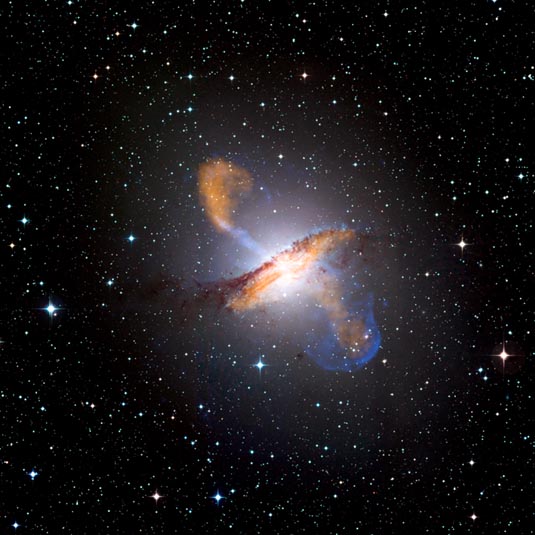
Elliptical Galaxy
RA 13h 25m 27.62s | Dec -43° 1' 8.8"
Centaurus
6 pointings between 03/22/2007 - 05/30/2007
199 hours
X-ray (blue), Submillimeter (orange); Optical (white, brown)
Image is 24.3 arcmin across
About 11 million light years
X-ray: NASA/CXC/CfA/R.Kraft et al.; Submillimeter: MPIfR/ESO/APEX/A.Weiss et al.; Optical: ESO/WFI
January 30, 2009
Related Images: G0901 G1221 G1402
ABOUT THIS IMAGE:
This image of Centaurus A shows a spectacular new view of a supermassive black hole's power. Jets and lobes powered by the central black hole in this nearby galaxy are shown by 870 micron submillimeter data (colored orange) from the Atacama Pathfinder Experiment (APEX) telescope in Chile and X-ray data (colored blue) from the Chandra X-ray Observatory. Visible light data from the Wide Field Imager on the Max-Planck/ESO 2.2 m telescope, also located in Chile, shows the dust lane in the galaxy and background stars. The X-ray jet in the upper left extends for about 13,000 light years away from the black hole. The APEX data shows that material in the jet is travelling at about half the speed of light.
Centaurus A is our nearest giant galaxy, at a distance of about 11 million light-years in the southern constellation of Centaurus. It is an elliptical galaxy, currently merging with a companion spiral galaxy, resulting in areas of intense star formation and making it one of the most spectacular objects in the sky. Centaurus A hosts a very active and highly luminous central region, caused by the presence of a supermassive black hole (see eso0109), and is the source of strong radio and X-ray emission.
In
the image, we see the dust ring encircling the giant galaxy, and the fast-moving
radio jets ejected from the galaxy center, signatures of the supermassive
black hole at the heart of Centaurus A. In submillimeter light, we see
not only the heat glow from the central dust disc, but also the emission
from the central radio source and – for the first time in the submillimeter–
the inner radio lobes north and south of the disc. Measurements of this
emission, which occurs when fast-moving electrons spiral around the lines
of a magnetic field, reveal that the material in the jet is travelling
at approximately half the speed of light. In the X-ray emission, we see
the jets emerging from the center of Centaurus A and, to the lower right
of the galaxy, the glow where the expanding lobe collides with the surrounding
gas, creating a shockwave.